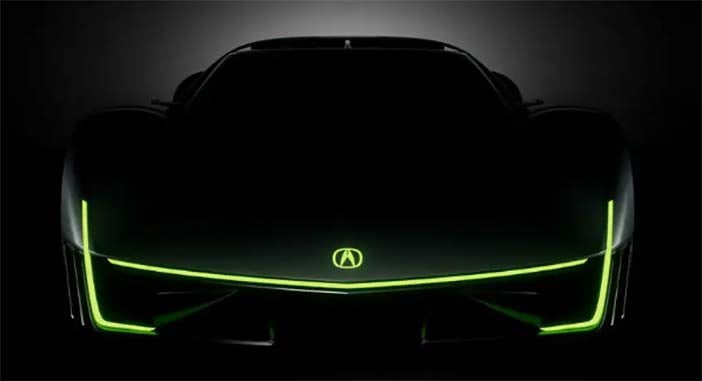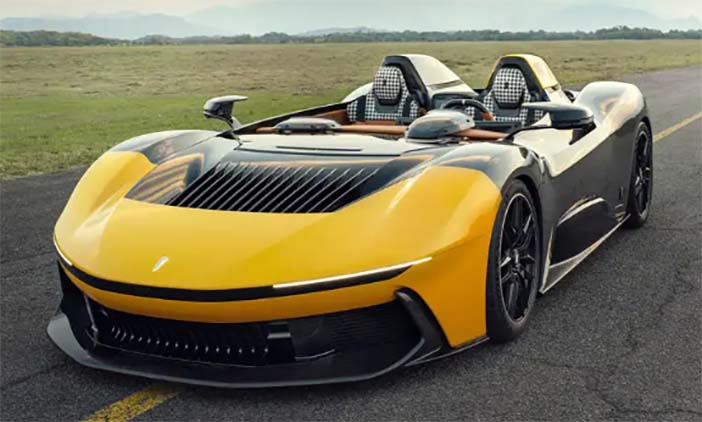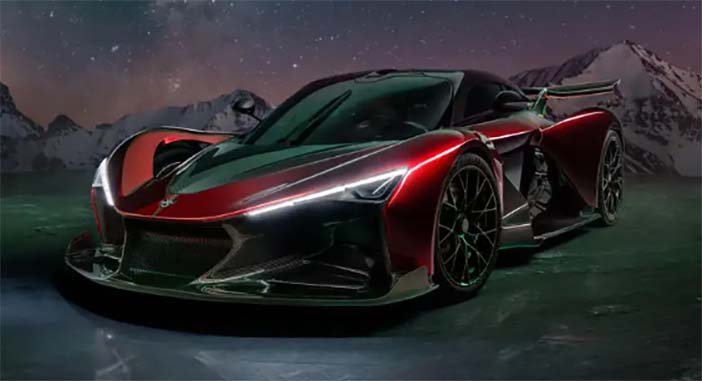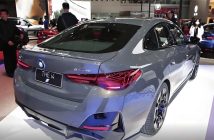+++ The Volkswagen Group’s surprise announcement in July that it would invest in Xpeng is symptomatic of the shift in relationships between western car makers in CHINA and their once junior Chinese partners. When foreign firms first accepted China’s ruling that they must form joint ventures (JVs) with local companies in order to gain access to what’s now the world’s largest car market, the relationship was one of master and pupil. Increasingly, however, the roles have shifted as Chinese firms’ speeds of vehicle development (especially on software and batteries) have outpaced those of their one-time superiors. Those global firms with sizeable markets to protect in China are increasingly admitting that they need to join forces with local players or face losing even more market share than they already are, especially if it’s the cut-throat volume market they’re playing in. +++
+++ In the twilight of the muscle car era, demand for the new 486 horsepower FORD MUSTANG V8 is roaring. New versions of the Mustang muscle car will begin shipping next week and more than two thirds of the orders include the big, 5-liter V8 engine, Ford said Friday. Demand for roaring engines remains strong in an era when Detroit automakers are starting to phase out the rumbling gas burners and transition to electric vehicles in order to meet strict government emissions and fuel economy requirements. There are about 13.000 U.S. orders for the new Mustang, Ford says, which also can be equipped with a 4-cylinder turbocharged engine. Of those orders, 67% have the V8, and more than a quarter of the people seeking that Mustang want the 6-speed manual transmission, spokesman Mike Levine says. But muscle cars, at least new ones, are on their way out. General Motors announced in March that it will stop making the Chevrolet Camaro early next year as a 2024 model. The company wouldn’t rule out a replacement for the Camaro at a future date. Stellantis, formerly Fiat Chrysler Automobiles, will stop making gas versions of the Dodge Challenger and Charger muscle cars by the end of this year. But the company has plans to roll out a battery-powered Charger performance car sometime in 2024. Levine wouldn’t say whether this version of the Mustang would be the company’s last gas-powered muscle car. “That remains to be seen”, he said. There also could be an electric Mustang sports car in the future. Electric cars, with instant torque and a low center of gravity, often are faster and handle better than internal combustion vehicles. People are going for V8 Mustangs with stick shifts in part because they may be the last of the gas-powered muscle car era, said Guidehouse Insights eMobility analyst Sam Abuelsamid. “The most hardcore fans, they’re going to go out and grab one of these because you don’t know when it’s going to end”, he said. When a new Mustang comes out, the V8 order rate is almost always higher than the other available engines, as is the demand for manual transmissions, because fervent Mustang fans are often the first to order, Abuelsamid said. “We tend to see more demand from enthusiasts for the V8 whenever an all-new Mustang is introduced”, Jim Owens, Mustang brand manager, said in a prepared statement. The new Mustang, which is on the same underpinnings as the current version, is built at a factory in Flat Rock, Michigan, south of Detroit. The new V8 engine can produce up to 486 horsepower. +++
+++ Hyundai’s luxury brand GENESIS is expected to surpass the 1 million mark in cumulative global sales about eight years after its launch. The automaker said it sold a total of 983.716 Genesis cars worldwide through last month, since the brand was launched in November 2015: 682.226 cars were sold domestically and 301.490 overseas. Given that the brand sold an average of 20.000 cars per month this year, it is highly likely that the 1 million milestone will be exceeded this month. The brand’s bestselling model is the midsize sedan G80, with 380.127 sold since its release in July 2016, followed by the GV80 SUV with 170.000 and GV70 SUV with 150.000. Genesis is considered one of the driving forces behind Hyundai becoming the world’s third-largest automaker in terms of sales for the first time last year. Previously, the automaker’s highest rank was No. 5 after its sales surpassed 8 million units globally in 2014 and 2015. A Hyundai staffer said, “We have been recognized as a company that can create not only cost-effective vehicles but also competitive luxury cars through the Genesis brand”. +++
+++ The much-anticipated successor to the HONDA NSX appears to have been previewed as an ‘Electric Vision Design Study’ at Monterey Car Week. Images posted by sibling brand Acura show a sleek, low-set coupé with a forward-cab design, similar to that of the mid-engined NSX. It also features a rear light bar reminiscent of that on the first generation NSX. Its silhouette is very close to that shown under wraps in May 2022, when Honda confirmed it was working on a high-end, NSX-esque model as part of a €36 billion electrification strategy. Autointernationaal.nl reported in May that the firm is poised to reveal a new sports car in celebration of its 75th anniversary. Europe vice president Tom Gardner told: “We will characterise the brand, particularly in Europe, as 2 words (we work very closely with R&D to ensure that our products will embody this) which are ‘advanced’ and ‘sporty’. “Honda has a very strong technology base. Not technology just for the sake of technology, but technology that adds new value to customers. “And we love a sports car. We love performance, and we’re very grateful for the strong reaction we’ve had to the latest Type R. There is huge demand for it, and the performance has been very well appreciated. We really enjoyed seeing it nail the Nürburgring record in the last month, and that is an important part of our brand”. He would not go so far as to reveal the positioning of the new model or its powertrain but did suggest that it’s imminent and that it could be as important as the last sports car that marked a Honda anniversary: “Watch this space: 2023 is 75 years. We had the S2000 at 50. Who knows…” Dave Marek, executive creative director of Acura, today ratified Gardener’s statement, saying: “Our Acura design team in Los Angeles is dreaming up the future of Acura Precision Crafted Performance in the EV era. This latest expression of an all-electric high-performance model is inspiring everyone in our studio to push the boundaries and we wanted to share the fun with our Acura fans”. Given the model was not shown in full, it seems likely that the concept will be revealed as part of any 75th anniversary celebrations, which would take place in late September. The second-generation NSX was originally shown as a near-production concept in 2012, 5 years before production began. It recently bowed out with the Type S special edition. Other possibilities for a new sports car remain, however. Reports of a revived S2000 have been circulating for several years. In 2017, then Honda CEO Takahiro Hachigo expressed a keen interest in the prospect of a follow-up to the seminal roadster, launched in 1999: “I’ve already heard many voices expressing they’d like a next-generation S2000. Honda development engineers are quick to develop sporty cars if the requests are there”, he said. Honda also confirmed a new GT-style model in its May 2022 announcement, with it and the NSX successor forming part of a wave of 30 new EVs being launched globally by 2030. “Honda always has a passion to offer fun for its customers”, the firm said at the time, promising it will continue to offer a “sports mindset and distinctive characteristics”. In December 2022, one of Honda’s lead engineers, Hideki Kakinuma, told that “without Type R, there is no Honda”, confirming that there is a place for the acclaimed performance division in the electrified era. +++

+++ HYUNDAI has acquired General Motors India’s Talegaon plant in response to growing demand in India’s rapidly expanding automotive market, Korea’s largest carmaker said Wednesday. The company signed an agreement to take over the assets of GM India’s Talegaon plant located in Gurugram, Haryana state. The signing ceremony was attended by about 20 officials from both companies, including Kim Eun-soo, executive vice president of Hyundai Motor India’s (HMI) Middle East & Africa Strategic Region, and Asif Khatri, vice president of production at GMI. “This year will mark a new milestone in Hyundai’s 27-year history in India”. Kim said. “Starting from the full-scale operation of the Talegaon plant in 2025, we will establish an advanced manufacturing hub that can contribute to the growth of the Indian automotive industry”. If the preliminary conditions, including approval from the Indian government, are met within this year, Hyundai Motor India will fully acquire the rights to the designated land and facilities of GMI’s Talegaon plant. Hyundai’s decision to acquire GMI’s Talegaon plant aims to strengthen its leadership in the fast-growing Indian automotive market and actively respond to the rapid electrification transition in India. India, with the world’s largest population, rose to become one of the top three global automotive markets, selling 4.76 million vehicles last year, following China (23.2 million vehicles) and the U.S. (14.2 million vehicles). The passenger car market is expected to exceed 5 million vehicles by 2030. The Indian government recently set a goal to expand the share of electric vehicle (EV) sales to 30 percent of total vehicle sales by 2030 and is aggressively pursuing strong electrification policies. Hyundai sold a total of 552.511 vehicles in India last year, capturing a 14.5 percent market share and securing the second position after Maruti. As of last month, Hyundai maintained its second position with a 14.6 percent market share, having sold 346.711 vehicles. However, despite the growth, there were limitations to meeting the increasing demand in India’s automotive market due to production capacity constraints. By acquiring GMI’s Talegaon plant, Hyundai aims to secure additional production capacity to expand the supply of high-demand core models and establish a system to introduce various models swiftly. The Talegaon plant has an existing annual production capacity of approximately 130.000 vehicles and is expected to begin full-scale production in 2025. In addition, Hyundai plans to establish a local EV production system to respond proactively to the anticipated rapid growth of the Indian EV market. Although the scale of EV sales in India was only around 48.000 vehicles in the previous year, accounting for 1.2 percent of the passenger car market, it has grown more than 3-fold compared to 2021 and sales are expanding rapidly to reach 46.650 vehicles in the first half of this year, approaching last year’s annual sales volume. Annual EV sales are expected to reach 1 million vehicles by 2030. +++
+++ Major automakers in JAPAN are stepping up efforts to accelerate the development of electric vehicles, in a bid to catch up in the global market. There is a sense of crisis over a possible decline of the Japanese automobile industry if U.S., European and Chinese automakers continue to dominate the EV market. Technological innovation in areas such as batteries is seen as key to raising the brand value of Japanese EVs to the level of Japanese gasoline-powered cars. “We are firmly committed to making attractive EVs”, Toyota president Koji Sato has said. In April, Toyota announced a new target of releasing 10 EV models and selling 1.5 million units annually by 2026. The firm has also strengthened its organizational structure. According to research firm Marklines Co., U.S.-based Tesla led the global EV industry in 2022, with sales of 1.268.000 units. China’s BYD came in second, followed by other American, European and Chinese automakers. The Toyota group, which includes Daihatsu and Hino, sold only 20.000 units, or a market share of just 0.3%. With a full-fledged EV era looming as the world transitions to a carbon-free society, Toyota faces the urgent task of boosting its competitiveness through technological innovation in fields such as batteries. Other Japanese automakers are also rising to the challenge. Honda aims for all of its vehicles sold worldwide to be EVs and hydrogen-powered fuel cell vehicles by 2040. Subaru plans to offer 8 EV models in the next 5 years and to start EV production in the United States. Nissan, which launched the world’s first mass-produced EV, the Leaf, in 2010, will announce a new strategy this autumn. At a news conference in July, Nissan president Makoto Uchida said that his company will “strengthen the product lineup and enhance competitiveness”. The automaker also decided to invest up to €600 million in a new EV company founded by its French alliance partner, Renault. Nonetheless, tapping into the U.S. and Chinese markets is seen to be difficult for Japanese carmakers. To qualify for tax breaks in the United States, automakers must procure batteries locally in addition to manufacturing vehicles in the country. In China, there is intense competition for technologies such as autonomous driving and voice recognition, in addition to the race for electrification. As there are limits on in-house development of such technologies, foreign automakers are partnering with information technology and other companies. “The speed of change is much faster than expected”, a senior executive at a major Japanese automaker said. “Japanese automakers can’t compete by focusing only on fuel efficiency and durability”, said Takaki Nakanishi, chief analyst at Nakanishi Research Institute. “They need to promote not only electrification but also digitalization and software development, and improve the commercial value of vehicles”. +++
+++ JLR is recruiting 300 new technicians as it ramps up Range Rover production and pushes forward with future EV development as part of a €17 billion, 5-year, investment push. The recruitment drive from the midlands-based firm, formerly known as Jaguar Land Rover, includes roles at its Gaydon, Whitley, and Solihull facilities. At Solihull plant, 100 of these roles will be maintenance technicians that will operate and maintain nearly 700 robots at the brand’s new €150 million automated body production facility. The new body shop will increase in Range Rover and Range Rover Sport production by 30%. These 100 technicians will also be trained to work on a new €80 million body production system that will be used to help build the new electric Range Rover. Future looking will be the focus of the other 200 new recruits: a mix of technicians and test engineers. Based at the Gaydon engineering centre and Whitley powertrain facility, they will work on testing and developing JLR’s next-generation electric vehicles. These EVs will start with the Range Rover electric at the end of 2024 (pre-orders to open later this year) followed by a trio of “jaw-dropping” electric Jaguar, the first of which will be a 2025-bound 4-door GT. Both will be built at Solihull, which along with the Wolverhampton engine plant and Halewood factory, will be transformed to produce electric vehicles as part of this €17 billion investment. ‘’Solihull and Gaydon are at the heart of our global operations and these roles are an opportunity for talented individuals to be part of our transformation to electrification”, said executive director of industrial operations Barbara Bergmeier. The investment has been applauded by Andy Street, Mayor of the West Midlands; an area rich in automotive history, and where Aston Martin is also based . “It’s great news that JLR are doubling down on their commitment to our region with this new announcement supporting the Range Rover and future of electric vehicles. The West Midlands is blessed with an exceptionally talented workforce and so I’m so pleased this has been recognised by JLR as they continue to broaden employment opportunities for local people here. The investment JLR is making will boost skills, prosperity, and opportunity for even more families in the months and years ahead”. The news comes just a few weeks after JLR owners Tata Group announced plans to create a 40GWh battery plant in Somerset. +++
+++ On August 10, in response to rumors that China’s new carmaker Xpeng Motors will acquire the internationally renowned luxury car brand MASERATI , a representative from Xpeng Motors told reporters that the rumors are false, and there is no related acquisition. +++
+++ Automobili PININFARINA has revealed a stunning electric barchetta, based on the underpinnings of the eye-catching, 1.900 hp Pininfarinha Battista coupé. Named the B95, the roofless hypercar was revealed at the Monterey Car Week and takes direct inspiration from the firm’s Pura SUV concept presented earlier this year. With 4 permanent-magnet synchronous motors, it sends power through all four wheels, with torque-vectoring to improve agility and stability as required. Its whopping 1.900 hp output allows it to dispatch the 0-100 kph sprint in fewer than 2.0 seconds, according to Pininfarina. It tops out at more than 300 kph, notably down on the Battista’s 360 kph top speed. Power comes from a 120 kWh battery pack that can be recharged at a rate of 270 kW, from 20-80% in 25 minutes. Pininfarina has yet to disclose a range, but the Battista is officially capable of driving 475 km between charges. Underpinning the B95 is the same Rimac-built carbonfibre monocoque as in the Battista. It’s exactly as long and tall as the coupé but measures 49 mm wider. It sits on 20 inch wheels at the front and 21 inch wheels at the rear, with aluminium centre locks. Electronically adjustable aero screens deflect air over the cabin, which is identical to that of the Battista. Bespoke helmets are available for order, said Pininfarina, allowing clients to match their car. Inside the cabin, the B95 gains a tan-leather dashboard with black trim, plus black and tan stitching. Just 10 examples of the B95 will be produced, priced from €4.4 million. Pininfarina said it will offer “unlimited bespoke opportunities” to buyers, as with the Battista. Autocar previously reported that the optional-extra spends on the 15 Battistas delivered thus far range from €400.000 to €1.400.000, with paint often being the most costly choice. Pininfarina is set to drastically expand its operations in the coming years. It recently unveiled the Pura Vision, a concept previewing a rakish electric SUV that might eventually make it to production. The B95 is the first road-going model to take inspiration from the Pura Vision. +++

+++ The arrival of the ZENVO AURORAmarks the rebirth of the niche Danish supercar maker as it moves away from the brutalist ST1 and TSR models that have defined its 16-year history. “We sat down in the beginning and questioned what this car should be”, chairman and chief commercial officer Jens Sverdrup told. “Why should I buy this car? Why a Zenvo?”. The answer it landed on was a whopping great V12, measuring 6.6 litres in displacement and packing a quartet of turbochargers. Named Mjølner, after Thor’s hammer, it produces 1.250 hp at 8.000 rpm before thwacking against the redline 1.800 rpm later. “If an alien happens to land at a racetrack and they hear a couple of [our] V12s, they will have their hairs standing up and tears running from their eyes”, Sverdrup said. “We are emotional beings, and the sound matters”. “It’s the last chance” to produce such an extravagant engine, he added, but an element of hybridisation was still required to ensure compliance with the upcoming Euro 7 emissions regulations. To this end, the fastest Aurora receives 3 electric motors of 200 hp each, integrated into the powertrain and one on each front wheel, bumping total system output to 1.880 hp. Zenvo claims this is enough to dispatch the 0-100 kph sprint in 2.3sec, faster than a Bugatti Chiron Super Sport, before powering onto a top speed of 450 kph. It is also capable of driving roughly 21 miles on electric power alone, enough to silently sneak out of town or a village on the way to a track day. “It’s getting less and less acceptable to fire up a V12 at 5 o’clock in the morning”, said Sverdrup, joking. In spite of the Aurora’s huge power output, Sverdrup claimed the brief was never about chasing headline-grabbing figures. He said: “We don’t care how fast it is at the Nürburgring, because it will be fast anyway. For me, it’s better if you are able to get in and out of the car easily. That’s worth way more to me than adding or subtracting a second on track”. As such, the firm has concentrated its efforts on maximising mechanical grip rather than that from aerodynamic appendages. “I don’t need downforce driving around on Sunday morning”, said Sverdrup. Inside, the aim was for the Aurora to immerse the driver as much as possible while remaining “pragmatic” about the car’s technologies and connectivity. In turn, there are no large infotainment displays. Apple CarPlay and Android Auto smartphone mirroring are instead provided through 1 of 3 digital instrument screens, in similar fashion to the Audi TT. Explaining the absence of a conventional infotainment touchscreen, Sverdrup said: “You drive these cars to escape. It’s like a motorcycle in a way. You go out for a drive to [disconnect and] clear your head a little bit”. The Aurora will be offered in 2 specifications: ‘Agil’ (agile) and ‘Tur’ (touring). The former is a track-focused proposition that omits the 2 front motors (making it rear-wheel drive) for a dry weight of 1.300 kg, adding an array of aerodynamic appendages to enhance grip. The Tur model, on the other hand, is 4-wheeldrive with torque vectoring at the front axle, intended to provide more secure on-road performance, given the absence of the Agil’s aerofoils and large rear spoiler. As well as the additional motors, the Tur receives a more sumptuous interior, which contributes to a 150kg increase in its dry weight. In either guise, the Aurora is clearly a high-performance machine: air dams run through the entire length of the low-set hypercar, and its carbonfibre monocoque is exposed on each flank. “We’ve got nothing to hide,” said Sverdrup. Prices will start at €3.6 million, Sverdrup said, with an indeterminate premium for customisation and optional extras. Zenvo plans to build 100 cars in total (50 of each specification) from 2025, with customer deliveries starting a year later. +++



